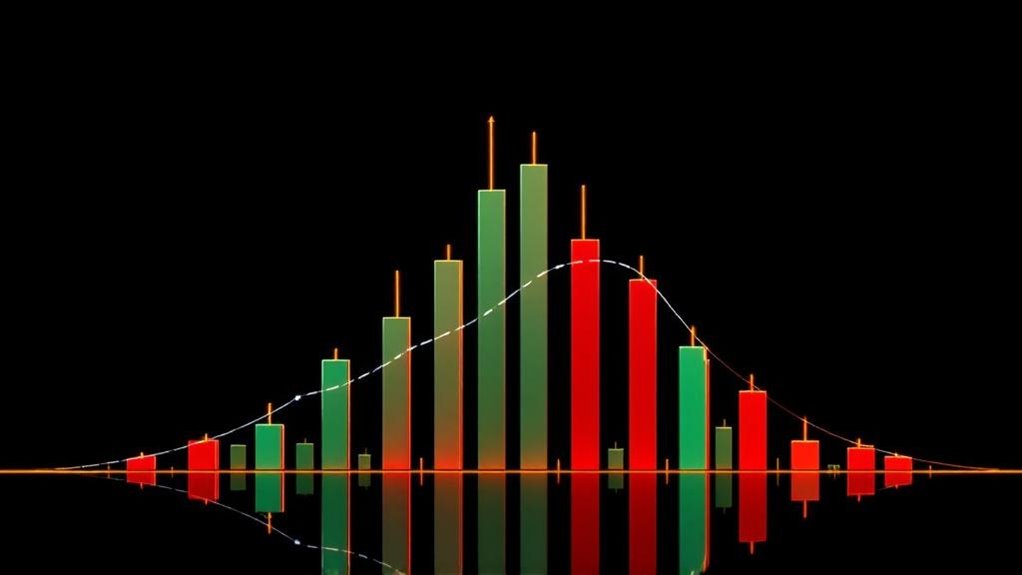Mean reversion trading capitalizes on the statistical principle that extreme price movements tend to return to historical averages, with market corrections typically spanning weeks and showing 10-20% declines. Statistical tools like Z-scores, Bollinger Bands, and RSI indicators help traders identify potential reversal points, while systematic position sizing and stop-loss placement at 1.5-2 times ATR manage risk exposure. Historical data reveals an 86.84% win rate for RSI-based mean reversion strategies in S&P 500 corrections, suggesting significant potential for those who master these technical methodologies.
Key Takeaways
- Mean reversion theory indicates that extreme price movements are unsustainable, with market forces naturally pulling values back toward historical averages.
- Price corrections typically last weeks to months, with declines ranging from 10-20% before reverting to equilibrium levels.
- RSI, Bollinger Bands, and moving averages help identify overbought or oversold conditions where price reversions are likely to occur.
- Successful mean reversion trading requires strict position sizing (1-2% per trade) and stop losses at 1.5-2 times ATR.
- Historical data shows 86.84% success rate for RSI-based mean reversion strategies during S&P 500 corrections since 1929.
The Science Behind Mean Reversion Theory

The scientific foundation of mean reversion theory rests upon well-established statistical principles that demonstrate how financial asset prices tend to oscillate around a central equilibrium point over time. This mathematical framework quantifies the likelihood of price corrections based on deviations from historical averages.
Statistical analysis of historical data reveals that extreme price movements typically prove unsustainable, as market forces naturally pull values back toward their long-term means. The underlying mean reversion psychology manifests through predictable patterns of investor behavior, including overreaction to news events and subsequent corrections. When properly analyzed, moving average indicators can help investors identify optimal entry and exit points for trades. Understanding exponential averages provides traders with more responsive signals during volatile market conditions.
Market extremes inevitably self-correct as psychological forces and historical patterns drive prices back toward their equilibrium values.
Empirical evidence supports this phenomenon across multiple asset classes, with larger deviations statistically correlating to higher probabilities of mean reversion. The theory’s practical applications extend to various quantitative trading strategies, utilizing tools such as standard deviation bands and moving averages to identify potential reversal points.
Critical metrics for analysis include:
- Price-to-earnings ratios
- Dividend yields
- Volume indicators
- Statistical Z-scores
Essential Components of Price Corrections
Several essential components consistently characterize price corrections across financial markets, forming a complex interplay of technical, fundamental, and psychological factors that drive asset valuations back toward their intrinsic means. Market psychology and investor behavior serve as primary catalysts, with sentiment shifts capable of triggering rapid price adjustments of 10-20% from recent highs. Investors often view these events as buying opportunities during market downturns.
| Component | Characteristic |
|---|---|
| Duration | Weeks to months |
| Magnitude | 10-20% decline |
| Catalyst | Sentiment/macro events |
The corrective process typically manifests through three distinct phases: initial recognition of overvaluation, accelerated selling pressure driven by heightened risk perception, and eventual stabilization as prices approach historical means. Institutional responses to macroeconomic shifts, such as interest rate changes or geopolitical events, can amplify these corrections through systematic reallocation of capital and modification of risk parameters. Technical indicators, including deviation from moving averages, often provide early warning signals of impending corrections. Successful traders maintain strict stop-loss orders to protect against excessive losses during volatile correction periods.
Statistical Tools for Mean Reversion Trading

Successful mean reversion trading strategies rely heavily on sophisticated statistical tools that help identify probable price reversal points and ideal entry/exit positions within market cycles.
Advanced technical indicators enable traders to quantify market dynamics and evaluate statistical significance in price movements. Z Score analysis and regression testing provide mathematical frameworks for measuring price extremes against historical norms, while Moving Averages establish baseline trends for potential reversions. The Augmented Dickey-Fuller test helps determine if a price series exhibits stationary, mean-reverting behavior.
Bollinger Bands incorporate trading volatility metrics by plotting standard deviation-based channels that signal overbought and oversold conditions. The Double Bollinger Bands strategy enhances precision by using multiple standard deviation levels to assess trade momentum.
Momentum Oscillators, including RSI and Stochastic indicators, complement these tools by measuring the strength of price movements and identifying potential exhaustion points. When these technical indicators converge to indicate statistical outliers, traders gain enhanced confidence in executing mean reversion positions.
The systematic application of these analytical tools helps remove emotional bias from trading decisions while optimizing entry and exit timing through quantitative measurement of market conditions.
Building a Mean Reversion Trading Strategy
While developing a robust mean reversion trading strategy requires methodical planning and rigorous testing, traders must first establish an extensive framework that incorporates multiple critical elements. The process demands meticulous attention to data segmentation, parameter optimization, and continuous performance monitoring. Market participants should focus on finding opportunities where price action shows moving average divergence to maximize potential returns. Volume price divergence analysis provides crucial confirmation signals for mean reversion trades.
| Strategic Component | Implementation Approach |
|---|---|
| Entry Triggers | Statistical deviations, RSI extremes |
| Signal Confirmation | Volume analysis, momentum indicators |
| Trade Execution | Liquidity assessment, timing optimization |
| Exit Strategies | Profit targets, trailing stops |
| Strategy Adaptation | Regular performance review, parameter adjustments |
Successful implementation requires careful asset selection based on historical mean-reverting tendencies and sufficient liquidity for efficient market timing. Traders must validate their approach through thorough backtesting while avoiding excessive optimization that could lead to curve-fitting. The framework should incorporate dynamic elements allowing for strategy adaptation as market conditions evolve, ensuring sustained performance across various market regimes.
Market Conditions That Support Price Reversals

Identifying specific market conditions that support price reversals represents a critical component of mean reversion trading success. Market participants can recognize potential reversals through the convergence of multiple technical indicators and fundamental catalysts that signal exhaustion of prevailing trends.
- Strong support and resistance barriers create natural turning points where price action frequently reverses course, particularly when accompanied by increased trading volume and momentum shifts.
- Extreme RSI signals above 70 or below 30 indicate overbought or oversold conditions, suggesting imminent mean reversion opportunities as markets digest extended moves.
Similar to how appraisers utilize empirical market data to validate their adjustments, traders must rely on concrete evidence when identifying potential reversal points.
- Dramatic sentiment shifts measured through tools like the Fear and Greed Index often precede major market reversals when emotional extremes reach unsustainable levels.
- Outside reversal patterns validated by volatility spikes and substantial volume surges demonstrate institutional participation and conviction behind potential trend changes.
RSI divergence signals can provide additional confirmation when price movement contradicts momentum readings. When these conditions align, traders gain enhanced confidence in identifying probable price corrections and executing mean reversion strategies with greater precision.
Risk Management in Mean Reversion Trading
Beyond identifying favorable market conditions, the implementation of robust risk management protocols forms the cornerstone of profitable mean reversion trading strategies.
Effective risk control begins with systematic position sizing, limiting exposure to 1-2% of trading capital per trade while adjusting position size inversely to market volatility.
Disciplined stop loss placement serves as a critical defense mechanism, with traders typically setting stops at 1.5-2 times the Average True Range (ATR) from entry points.
During periods of elevated volatility, prudent risk management dictates wider stops coupled with reduced position sizes, often scaling down to 50% of standard allocations.
Utilizing tools like Bollinger Bands helps traders identify overbought and oversold conditions to make more informed risk management decisions.
The integration of dynamic trailing stops helps secure profits as price action evolves, while diversification across multiple uncorrelated assets provides additional risk mitigation.
Incorporating RSI divergence patterns can provide early warnings of potential trend reversals, helping traders better time their exits and protect capital.
Successful mean reversion traders maintain strict adherence to these predefined risk parameters, avoiding discretionary decisions that could compromise systematic trading principles.
Real-World Examples of Successful Reversions
Market overreactions frequently present compelling opportunities for mean reversion trading, as evidenced by the S&P 500‘s behavior during October 2020, when the index demonstrated a textbook recovery following an oversold RSI reading below 30.
Particularly, energy sector stocks have exhibited especially pronounced mean reversion tendencies, with oversold conditions consistently preceding significant rebounds during periods of broader market stability. Trading signals are most reliable when the market maintains its position above 200-day MA. Setting proper stop-loss orders helps protect against unexpected trend reversals while pursuing mean reversion opportunities.
The empirical data from multi-year backtesting reveals that range-bound corrections in the S&P 500 have yielded an impressive 86.84% win rate when employing RSI-based mean reversion strategies with defined exit parameters at the 40 RSI threshold.
Market Overreactions: Energy Stocks
Dramatic overreactions in energy stocks provide some of the most compelling examples of mean reversion in financial markets, particularly during periods of heightened geopolitical tension or macroeconomic uncertainty.
Market volatility and emotional trading frequently drive energy sector valuations to unsustainable extremes, creating opportunities for disciplined investors who recognize these temporal distortions. Technical analysis shows that these extreme price movements consistently return to their simple moving average, validating the mean reversion theory. Understanding these patterns helps traders identify key distribution phases during market peaks and troughs.
- WTI crude oil’s unprecedented collapse below $0 in April 2020, followed by a swift recovery above $40/barrel
- Natural gas prices surging 80%+ during the 2022 Russia-Ukraine conflict before reverting to historical means
- BP’s sharp decline during the 2010 Deepwater Horizon crisis, ultimately recovering substantial market capitalization
- Integrated oil majors Chevron and ExxonMobil exhibiting 30%+ rebounds within six months of the 2020 energy crisis
S&P 500 Range Corrections
The S&P 500’s historical correction patterns provide compelling evidence for mean reversion’s reliability as a trading strategy, with 56 documented corrections since 1929 offering extensive data on recovery trajectories and success rates.
Analysis of S&P 500 corrections reveals that 60% of these market downturns successfully reverted to positive territory rather than deteriorating into bear markets. The statistical data demonstrates robust mean reversion tendencies, with median recovery to 50% retracement occurring within just 15 days. Historical data shows that secular bull markets have produced average annualized returns of 14% over multiple decades. While market timing requires exceptional precision, mean reversion strategies have demonstrated more consistent results.
Recent examples reinforce these historical patterns, particularly evident in 2018’s dual corrections, each exceeding 10% decline before reverting within months.
The COVID-19 crash of March 2020 further validated this phenomenon, with the index experiencing a dramatic 30% decline followed by complete recovery to new highs by August 2020.
Advanced Techniques for Mean Reversion Analysis
Advanced statistical tools, including Kalman Filters and cointegration tests, form the quantitative foundation for sophisticated mean reversion analysis by enabling traders to validate statistical relationships and identify high-probability reversal opportunities.
Contemporary mean reversion strategies incorporate volatility-based entry points through regime analysis and adaptive Bollinger Bands, which help distinguish between temporary price extremes and structural market shifts. Traders can optimize their entries by using standard deviation bands to determine precise overbought and oversold conditions.
Pattern recognition algorithms further enhance mean reversion analysis by detecting historical correlation patterns across multiple timeframes and asset classes, while simultaneously filtering out statistical noise that could generate false signals.
Statistical Tools For Analysis
Modern mean reversion analysis employs five core statistical tools that form the foundation for sophisticated trading strategies: stationarity testing, signal extraction, pairs-based analysis, validation frameworks, and automated implementation systems.
These methodologies integrate statistical significance testing and model selection criteria to identify reliable trading opportunities within market fluctuations. Standard deviation extremes provide critical confirmation signals when prices deviate beyond normal boundaries. Combining multiple technical indicators helps reduce false signals and improves trading accuracy.
- Augmented Dickey-Fuller (ADF) and KPSS tests evaluate time series stationarity through rigorous mathematical frameworks
- Z-score normalization and Kalman filtering extract actionable signals from noisy market data
- Cointegration analysis identifies stable long-term relationships between correlated asset pairs
- Walk-forward optimization and Monte Carlo simulations validate strategy robustness across market regimes
The systematic application of these statistical tools enables traders to develop data-driven approaches for capitalizing on price corrections while maintaining disciplined risk management protocols.
Volatility-Based Entry Points
Building upon foundational statistical methodologies, volatility-based entry points represent a sophisticated advancement in mean reversion analysis that integrates dynamic market conditions with precise trade timing.
Volatility indicators like VIX and ATR serve as critical filters for identifying prime market timing opportunities during price extremes.
Professional traders leverage these metrics to establish precise entry thresholds, calibrating their risk exposure based on prevailing market conditions.
The application of systematic trading approaches helps investors capitalize on extreme price changes while maintaining disciplined risk management practices.
Trading signals are refined through the integration of Bollinger Bands set at two standard deviations, enabling traders to quantify statistically significant market corrections.
During periods of elevated volatility, mean reversion strategies often demand more stringent entry criteria, requiring deeper price excursions before signal activation.
This approach guarantees that trading decisions are grounded in statistical validity rather than subjective assessment.
Correlation Pattern Recognition
Pattern recognition algorithms revolutionize mean reversion analysis by deploying sophisticated statistical methods to identify and validate correlated price relationships across multiple asset classes.
Advanced machine learning techniques parse complex correlation dynamics and asset relationships through neural networks and clustering algorithms, enabling traders to detect subtle mean reversion opportunities.
- Kalman filters continuously adapt to shifting market conditions, providing real-time updates on correlation coefficients between paired assets.
- Deep learning models process vast datasets to uncover non-linear patterns in price relationships that traditional statistical methods might miss.
- Principal Component Analysis reduces market noise by isolating primary drivers of correlation across multiple asset pairs.
- AI-powered systems monitor thousands of potential pairs simultaneously, triggering alerts when statistically significant divergences occur.
Modern pattern recognition technology has transformed the identification of mean reversion opportunities from an art to a precise science.
The most reliable trading signals emerge when assets deviate by two standard deviations from their historical mean, providing optimal entry points for mean reversion strategies.
Frequently Asked Questions
How Long Does It Typically Take for Prices to Revert to Mean?
The mean duration for price normalization varies considerably based on market conditions and price volatility.
Typical timeframes include:
- Intraday corrections: Minutes to hours
- Short-term reversions: 3-7 trading days
- Intermediate adjustments: 2-4 weeks
- Long-term realignments: 3-6 months
Higher volatility generally accelerates the reversion process, while stable markets experience more gradual corrections.
Asset liquidity and broader economic factors also influence the speed of price normalization.
Can Mean Reversion Strategies Work Effectively in Cryptocurrency Markets?
Mean reversion strategies can be effectively implemented in cryptocurrency markets, though success requires careful consideration of heightened cryptocurrency volatility and disciplined trading psychology.
Research indicates these approaches have achieved notable returns, with combined strategies yielding approximately 98.43% annualized returns in Bitcoin markets.
However, practitioners must account for more extreme price deviations and potentially longer reversion periods compared to traditional assets, while maintaining strict risk management protocols to protect against extended drawdowns.
What Percentage Deviation From Mean Typically Signals a Reliable Trading Opportunity?
Research indicates that price movements exceeding ±2 standard deviations from the mean typically signal reliable trading opportunities, with a 95% probability of reversion.
Key mean thresholds include:
- 2 standard deviations: Ideal balance of signal frequency and reliability
- Z-scores beyond ±2: Strong statistical confirmation
- RSI readings above 70 or below 30
- CCI extremes at ±100
These deviation metrics, when used in combination, provide robust statistical validation for potential price corrections toward the mean.
Are Mean Reversion Strategies More Successful in Specific Market Sectors?
Like a metronome keeping steady time, defensive sectors such as utilities, consumer staples, and telecommunications demonstrate superior mean reversion characteristics.
Analysis shows these sectors consistently outperform in mean reversion strategies due to their stable cash flows and lower market volatility.
Sector performance data indicates success rates of 65-78% in mature, range-bound markets versus more volatile growth sectors.
Financial data confirms higher reliability in pairs trading within correlated defensive stocks and sector-specific ETFs.
How Often Should Traders Recalculate or Adjust Their Mean Reference Points?
The ideal mean recalibration frequency depends on several key market factors, including volatility levels and trading timeframes.
Professional traders typically adjust reference point adjustments based on:
- High-frequency strategies: Every few seconds to minutes
- Intraday trading: Multiple times per day
- Swing trading: Daily or weekly updates
- Long-term positions: Monthly recalibrations
The frequency should align with the asset’s mean reversion characteristics while avoiding excessive adjustments that could introduce noise into trading signals.
Conclusion
While traders enthusiastically chase the holy grail of mean reversion strategies, the market’s sardonic tendency to defy statistical probability remains a humbling constant. Those who religiously worship at the altar of price corrections often discover that markets can remain “irrational” longer than their margin accounts remain solvent. Perhaps the greatest mean reversion of all is how consistently trading strategies return to their inherent mediocrity, despite practitioners’ sophisticated mathematical gymnastics.
References
- https://trendspider.com/learning-center/mean-reversion-trading-strategies/
- https://www.tradingwithrayner.com/mean-reversion-trading-strategy/
- https://en.wikipedia.org/wiki/Mean_reversion_(finance)
- https://tiomarkets.com/en/article/mean-reversion-trading-strategy-your-ultimate-guide
- https://www.ig.com/en/trading-strategies/what-is-mean-reversion-and-how-does-it-work–230605
- https://www.nasdaq.com/articles/mean-reversion:-definition-strategies-and-indicators
- https://www.yieldstreet.com/blog/article/decoding-mean-reversion/
- https://corporatefinanceinstitute.com/resources/career-map/sell-side/capital-markets/mean-reversion/
- https://www.home.saxo/learn/guides/financial-literacy/what-is-a-correction-in-trading
- https://www.fidelity.com/learning-center/trading-investing/corrections

